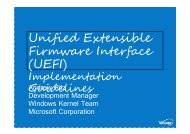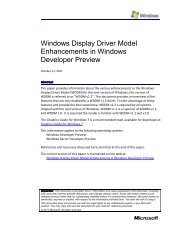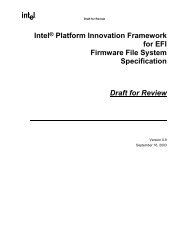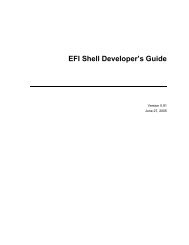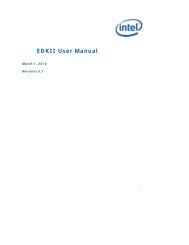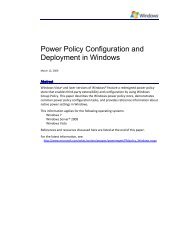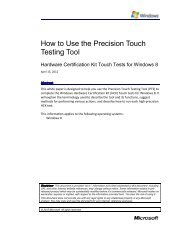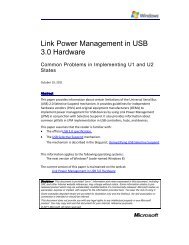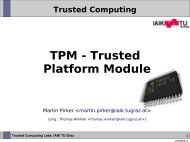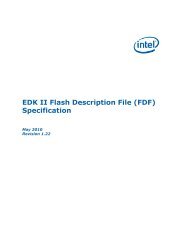SetupDesignGuide.pdf - Firmware Encoding Index
SetupDesignGuide.pdf - Firmware Encoding Index
SetupDesignGuide.pdf - Firmware Encoding Index
Create successful ePaper yourself
Turn your PDF publications into a flip-book with our unique Google optimized e-Paper software.
Setup Design Guide<br />
DRAFT<br />
The driver will do the hardware interaction and return a packet of data to the database and it will fill in<br />
the appropriate string data. If the packet is returned successfully, the DYNAMIC flag is turned off.<br />
This string data would likely correlate to the initial list of file systems available on the system. This<br />
completes the first phase of interaction to acquire all the information the system needs to display data to<br />
the user.<br />
Additionally, when the user manually selects the file system they want to start searching, a callback to<br />
the exporting driver would occur and a packet would return the data requested. This would continue<br />
until the desired file was chosen.<br />
In the case where the driver which is exporting data bypasses the HII database and sends the data<br />
directly to the EFI configuration driver, the driver becomes responsible for the saving of the NVRAM<br />
data if any. Additionally, bypassing the HII database along with the multiple iteration callbacks are not<br />
compatible with runtime propagation. This use case would likely be used by pre-boot only utilities like<br />
the EFI Boot Maintenance Manager.<br />
Human Interface Infrastructure<br />
Database<br />
Consists of IFR/String/Font<br />
Which has been submitted by varying EFI drivers<br />
EFI Driver/Utility<br />
Requiring Dynamic Hardware Interaction<br />
EFI Configuration Driver<br />
Provides User Interface Support<br />
Callable by a Protocol Interface<br />
EFI Driver/Utility<br />
Requiring Dynamic Hardware Interaction<br />
Pre-boot Only and Responsible<br />
for storing NVRAM changes<br />
Additionally, a driver which required multiple iteration support could use the HII database so that the<br />
data might have a presence in the O/S runtime. The practical situation for this might be a driver which<br />
has a large amount of questions and possibly only a very small set which require multiple iteration<br />
support. In this case, the developer needs to be conscious when designing the page contents of the VFR<br />
script so that if the O/S runtime version of the data is stripped of op-codes with the INTERACTIVE<br />
flag turned on the user experience will not be odd. For instance, if a driver contains a page dedicated to<br />
modem initialization and the op-codes associated with that page are all set to INTERACTIVE, it might<br />
look very odd if the O/S runtime user is presented with a blank page which inferred there should be<br />
more data.<br />
2.7 Setup Infrastructure Overview Graphic<br />
22



